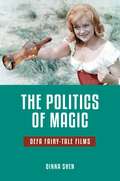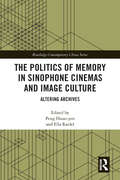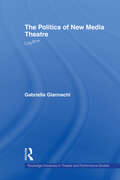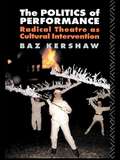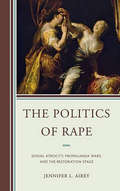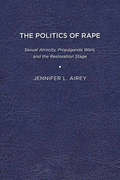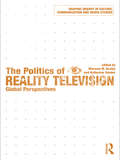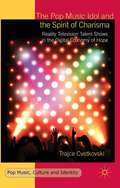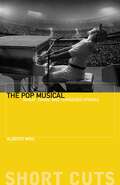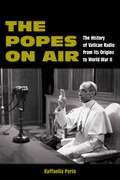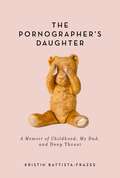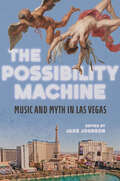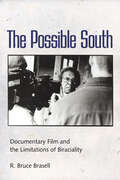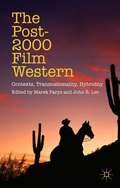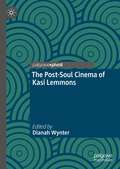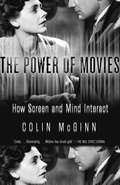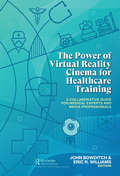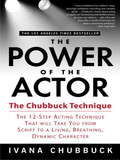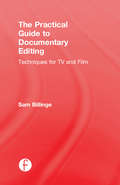- Table View
- List View
The Politics of Magic: DEFA Fairy-Tale Films (Series in Fairy-Tale Studies)
by Qinna ShenFrom Paul Verhoeven's The Cold Heart in 1950 to Konrad Petzold's The Story of the Goose Princess and Her Loyal Horse Falada in 1989, East Germany's state-sponsored film company, DEFA (Deutsche Film-Aktiengesellschaft), produced over forty feature-length, live-action fairy-tale films based on nineteenth-century folk and literary tales. While many of these films were popular successes and paved the way for the studio's other films to enter the global market, DEFA's fairy-tale corpus has not been studied in its entirety. In The Politics of Magic: DEFA Fairy-Tale Films, Qinna Shen fills this gap by analyzing the films on thematic and formal levels and examining their embedded agendas in relation to the cultural politics of the German Democratic Republic. In five chapters, Shen compares the films with earlier print versions of the same stories and analyzes revisions made in DEFA's film adaptations. She also distinguishes the DEFA fairy-tale films from National Socialist, West German, and Disney adaptations of the same tales. Her archival work reconstitutes the cultural-historical context in which films were produced and received, and incorporates the films into the larger narrative of DEFA. For the first time, the banned DEFA fairy-tale comedy, The Robe (1961/1991), is discussed in depth. The book's title The Politics of Magic is not intended to suggest that DEFA fairy-tale films were merely mouthpieces of official ideology and propaganda. On the contrary, Shen shows that the films run the gamut from politically dogmatic to implicitly subversive, from kitschy to experimental. She argues that the fairy-tale cloak permitted them to convey ideology in a subtle, indirect manner that allowed viewers to forget Cold War politics for a while and to delve into a world of magic where politics took on an allegorical form. The fact that some DEFA fairy-tale films developed an international audience (particularly The Story of Little Mook and Three Hazelnuts for Cinderella) not only attests to these films' universal appeal but also to the surprising marketability of this branch of GDR cinema and its impact beyond the GDR's own narrow temporal and geographic boundaries. Shen's study will be significant reading for teachers and students of folklore studies and for scholars of German, Eastern European, cultural, film, media, and gender studies.
The Politics of Memory in Sinophone Cinemas and Image Culture: Altering Archives (Routledge Contemporary China Series)
by Peng Hsiao-Yen Ella RaidelCinema archives memories, conserves the past, and rewrites histories. As much as the Sinophone embodies differences, contemporary Sinophone cinemas in Taiwan, Hong Kong, and the People’s Republic of China invest various images of contested politics in order to assert different histories and self-consciousness. As such, Sinophone cinemas and image production function as archives, with the capability of reinterpreting the multiple dimensions of past and present. The Politics of Memory in Sinophone Cinemas and Image Culture investigates Sinophone films and art projects that express this desire for archiving and reconfiguring the past. Comprising ten chapters, this book brings together contributors from an array of disciplines - artists, filmmakers, curators, film critics, and literary scholars - to grapple with the creative ambiguities of Sinophone cinemas and image culture. Blending eclectic methods of scholarly research, knowledge-making, and art-making into a new discursive space, the chapters address the diverse complexities of the cinematic culture and image production in Sinitic language regions. This book is a valuable resource for students and scholars of film studies, China studies, East Asian studies, Taiwan studies, and Sinophone studies, as well as professionals who work in the film industry.
The Politics of Monstrous Figures in Contemporary Cinema: Witches, Zombies, and Cyborgs Re-enchanting the Ends of the World (Horror and Gothic Media Cultures)
by Francesco SticchiThe book addresses the role of particular monstrous figures and apocalyptic scenarios in contemporary cinema and television and evaluates the political potential of horror and sci-fi narratives in our age of never-ending crises. The purpose of the book is to demonstrate how witches, zombies, and cyborgs (among other figures) present the spectre of new people to come, of new possibilities to inhabit the Earth against the apocalyptic fates of Capitalism. Written in an 'acid communist' spirit, the book shows how it is possible to politicise contemporary popular culture tropes and figures, mapping the anxieties they express and also their undisclosed potential and resources. Balancing personal commentary and academic analyses, the book expresses Deleuzian trust in the power of moving images as instruments that allow us to inhabit the present and believe in this world notwithstanding alleged ends of all worlds.
The Politics of New Media Theatre: Life®™ (Routledge Advances in Theatre & Performance Studies #Vol. 6)
by Gabriella GiannachiThe first book in the field to explore the links between theories of globalization and surveillance, bipower and biopolitics, performance and theatre, computer arts and politics, "The Politics of New Media Theatre" is an investigation into the political role played by the new media theatre. Gabriella Giannachi explores how new media arts constitute themselves as a radical political movement, and presents an analysis of both the role of virtuality in radical performance and politics in virtual and mixed reality practices. This outstanding new work offers an analysis of leading political, philosophical and artistic texts and artworks, and represents a milestone for anyone interested in new technologies, theatre and politics.
The Politics of Performance: Radical Theatre as Cultural Intervention
by Baz KershawThe Politics of Performance^ addresses fundamental questions about the social and political purposes of performance through an investigation into post-war alternative and community theatre. It proposes a theory of performace as ideological transaction, cultural intervention and community action, which is used to illuminate the potential social and political effects of radical performance practice. It raises issues about the nature of alternative theatre as a movement and the aesthetics of its styles of production, especially in relation to progressive counter-cultural formations. It analyses in detail the work of key practitioners in socially engaged theatre during four decades, setting each in the context of social, political and cultural history and focusing particularly on how they used that context to enhance the potential efficacy of their productions. The book is thus a detailed analysis of oppositional theatre as radical cultural practice in its various efforts to subvert the status quo. Its purpose is to raise the profile of these approaches to performance by proposing, and demonstrating how they may have had a significant impact on social and political history.
The Politics of Rape: Sexual Atrocity, Propaganda Wars, and the Restoration Stage
by Jennifer L. AireyThe Politics of Rape: Sexual Atrocity, Propaganda Wars, and the Restoration Stage is the first full-length study to examine representations of sexual violence on the Restoration stage. By reading theatrical depictions of sexual violence alongside political tracts, propaganda pamphlets, and circulating broadsides, this study argues that authors used dramatic representations of rape to respond to and engage with late-century upheavals in British political culture. Beginning with an examination of rape scenes in English Civil War propaganda, The Politics of Rape argues that Roundhead authors described acts of rape and atrocity to demonize their enemies, the Irish, the Catholics, and the Cavaliers. After the Restoration, propagandists and playwrights on each side of every political conflict would follow suit, altering the rhetoric of sexual violence in response to each new moment of political upheaval: The Restoration of Charles II, the Second and Third Anglo-Dutch Wars, the Popish Plot, the Exclusion Crisis, the Glorious Revolution, and the accession of William and Mary. The study offers an intensive look at British propaganda culture, gathering together a wealth of understudied pamphlet texts, and identifying a series of stock figures that recur throughout the century: The demonic Irishman, sexually violent villain of the 1641 Irish Rebellion tracts; the debauched Cavalier, the secretly Catholic royalist rapist; the poisonous Catholic bride, the malignant consort who encourages the rapes of Protestant women; the cannibal father, the evil patriarch who rapes his daughters-in-laws before ingesting his own sons as a symbol of monarchical overreach; and the ravished monarch, the male rape victim whose sexual violation protests his political disenfranchisement. The study also traces the appearance of these figures on the British stage, examining well-known works by Dryden, Rochester, Behn, Lee, and Shadwell, alongside lesser-known plays by Orrery, Howard, Settle, Crowne, Ravenscroft, Pix, Cibber, and Brady. The Politics of Rape thus offers a new method for understanding of the geo-political implications of theatrical sexual violence. Published by University of Delaware Press. Distributed worldwide by Rutgers University Press.
The Politics of Rape: Sexual Atrocity, Propaganda Wars, and the Restoration Stage
by Jennifer L. AireyThe Politics of Rape: Sexual Atrocity, Propaganda Wars, and the Restoration Stage is the first full-length study to examine representations of sexual violence on the Restoration stage. By reading theatrical depictions of sexual violence alongside political tracts, propaganda pamphlets, and circulating broadsides, this study argues that authors used dramatic representations of rape to respond to and engage with late-century upheavals in British political culture. Beginning with an examination of rape scenes in English Civil War propaganda, The Politics of Rape argues that Roundhead authors described acts of rape and atrocity to demonize their enemies, the Irish, the Catholics, and the Cavaliers. After the Restoration, propagandists and playwrights on each side of every political conflict would follow suit, altering the rhetoric of sexual violence in response to each new moment of political upheaval: The Restoration of Charles II, the Second and Third Anglo-Dutch Wars, the Popish Plot, the Exclusion Crisis, the Glorious Revolution, and the accession of William and Mary. The study offers an intensive look at British propaganda culture, gathering together a wealth of understudied pamphlet texts, and identifying a series of stock figures that recur throughout the century: The demonic Irishman, sexually violent villain of the 1641 Irish Rebellion tracts; the debauched Cavalier, the secretly Catholic royalist rapist; the poisonous Catholic bride, the malignant consort who encourages the rapes of Protestant women; the cannibal father, the evil patriarch who rapes his daughters-in-laws before ingesting his own sons as a symbol of monarchical overreach; and the ravished monarch, the male rape victim whose sexual violation protests his political disenfranchisement. The study also traces the appearance of these figures on the British stage, examining well-known works by Dryden, Rochester, Behn, Lee, and Shadwell, alongside lesser-known plays by Orrery, Howard, Settle, Crowne, Ravenscroft, Pix, Cibber, and Brady. The Politics of Rape thus offers a new method for understanding of the geo-political implications of theatrical sexual violence. Published by University of Delaware Press. Distributed worldwide by Rutgers University Press.
The Politics of Reality Television: Global Perspectives (Shaping Inquiry in Culture, Communication and Media Studies)
by Marwan M. KraidyThe Politics of Reality Television encompasses an international selection of expert contributions who consider the specific ways media migrations test our understanding of, and means of investigating, reality television across the globe. The book addresses a wide range of topics, including: the global circulation and local adaptation of reality television formats and franchises the production of fame and celebrity around hitherto "ordinary" people the transformation of self under the public eye the tensions between fierce loyalties to local representatives and imagined communities bonding across regional and ethnic divides the struggle over the meanings and values of reality television across a range of national, regional, gender, class and religious contexts. This book will be of interest to undergraduate and postgraduate students on a range of Media and Television Studies courses, particularly those on the globalisation of television and media, and reality television.
The Pop Music Idol and the Spirit of Charisma: Reality Television Talent Shows in the Digital Economy of Hope (Pop Music, Culture and Identity)
by Trajce CvetkovskiThis book makes a case for the synergetic union between reality TV and the music industry. It delves into technological change in popular music, and the role of music reality TV and social media in the pop production process. It challenges the current scholarship which does not adequately distinguish the economic significance of these developments.
The Pop Musical: Sweat, Tears, and Tarnished Utopias (Short Cuts)
by Professor Alberto MiraAfter Hollywood and Tin Pan Alley’s iron grip on the movie musical began to slip in the face of pop’s cultural dominance, many believed that the musical genre entered a terminal decline and finally wore itself out by the 1980s. Though the industrial model of the musical was disrupted by the emergence of pop, the Hollywood musical has not gone extinct. Many Hollywood productions from the 1960s to the present have revisited the forms and conventions of the classic musical—except instead of drawing from showtunes and jazz standards, they employ the styles and iconography of pop.Alberto Mira offers a new account of how pop music revolutionized the Hollywood musical. He shows that while the Hollywood system ceased producing large-scale traditional musicals, different pop strains—disco, rock ’n’ roll, doo-wop, glam, and hip-hop—renewed the genre, giving it a new life. While the classical musical presented a world light on conflict, defined by theatricality and where effortless talent can shine through, the introduction of pop spurred musicals to address contemporary social and political conditions. Mira traces the emergence of a new set of themes—such as the painful hard work depicted in Dirty Dancing (1987); the double-edged fandom of Velvet Goldmine (1998); and the racial politics of Dreamgirls (2006)—to explore why the Hollywood musical has found renewed relevance.
The Popes on Air: The History of Vatican Radio from Its Origins to World War II (World War II: The Global, Human, and Ethical Dimension)
by Raffaella PerinThe story of the origin of Vatican Radio provides a unique look at the history of World War IIThe book offers the first wide-ranging study on the history of Vatican Radio from its origins (1931) to the end of Pius XII’s pontificate (1958) based on unpublished sources. The opening of the Secret Vatican Archives on the records regarding Pius XII will shed light on the most controversial pontificate of the 20th century. Moreover, the recent rearrangement of the Vatican media provided the creation of a multimedia archive that is still in Fieri.This research is an original point of view on the most relevant questions concerning these decades: the relation of the Catholic Church with the Fascist regimes and Western democracies; the attitude toward anti-Semitism and the Shoah in Europe, and in general toward the total war; the relationship of the Holy See with the new media in the mass society; the questions arisen in the after-war period such as the Christian Democratic Party in Italy; the new role of women; and anti-communism and the competition for the consensus in the social and moral order in a secularized society.
The Pornographer's Daughter: A Memoir of Childhood, My Dad, and Deep Throat
by Kristin Battista-FrazeeMore than forty years after Deep Throat arrived on the cultural scene and inspired a sexual revolution, questions about the ethics of pornography and its impact on society are still being asked today and remain as controversial as ever. Kristin Battista-Frazee was only four years old in 1974 when her father, Anthony Battista, was indicted by the federal government for distributing the now famous porn film Deep Throat. As her father unexpectedly became an early pioneer in the emerging porn industry and transformed himself from Philadelphia stockbroker to porn broker, this indictment threatened his family's stability. The stress drove Kristin's mother, Frances Battista, to worry endlessly if her husband would be put in jail. She became so depressed that she attempted suicide.Kristin survived this family trauma to live a surprisingly normal life. But instead of leaving the past behind her, she developed a burning curiosity to understand her family's history. Why did the federal government so vehemently prosecute this case? And why did her father get involved in distributing this notorious porn film in the first place? Did the influence of pornography in fact make Kristin a better person? Answering these questions and reconciling her dramatic family history with her life as a wife and mother became her mission.The Pornographer's Daughter is an insider's glimpse into the events that made Deep Throat and pornography so popular, as well as what it was like to come of age against the backdrop of the pornography business.
The Portable Film School: Everything You'd Learn in Film School (Without Ever Going to Class)
by D. B. GillesThe Portable Film School is a private tutorial from an instructor at one of the nation's most prestigious film schools. D.B. Gilles explains the fundamental skills and techniques of screenwriting and making a short film arming you with the two calling cards you'll need to break into Hollywood – without having spent the tuition or a minute in a classroom.
The Portable Radio in American Life
by Michael Brian SchifferHistory of the development of the portable radio over the years.
The Possibility Machine: Music and Myth in Las Vegas (Music in American Life)
by Kelly Kessler Joanna Dee Das Jake Johnson James Deaville Robert Fink Janis McKay Louis Niebur Cassaundra Rodriguez Celine Ayala Kirstin Bews Laura Dallman Pheaross Graham Jessica A Holmes Maddie House-Tuck Michael Kinney Carlo Lanfossi Jason Leddington Sam Murray Lynda Paul Arianne Johnson Quinn Michael M Reinhard Laura Risk Arreanna Rostosky Brian F WrightSingular and star-studded writings on America’s neon-lit playground At once a Technicolor wonderland and the embodiment of American mythology, Las Vegas exists at the Ground Zero of a reverence for risk-taking and the transformative power of a winning hand. Jake Johnson edits a collection of short essays and flash ideas that probes how music-making and soundscapes shape the City of Second Chances. Treating topics ranging from Cher to Cirque de Soleil, the contributors delve into how music and musicians factored in the early development of Vegas’s image; the role of local communities of musicians and Strip mainstays in sustaining tensions between belief and disbelief; the ways aging showroom stars provide a sense of timelessness that inoculates visitors against the outside world; the link connecting fantasies of sexual prowess and democracy with the musical values of Liberace and others; considerations of how musicians and establishments gambled with identity and opened the door for audience members to explore Sin City–only versions of themselves; and the echoes and energy generated by the idea of Las Vegas as it travels across the country. Contributors: Celine Ayala, Kirstin Bews, Laura Dallman, Joanna Dee Das, James Deaville, Robert Fink, Pheaross Graham, Jessica A. Holmes, Maddie House-Tuck, Jake Johnson, Kelly Kessler, Michael Kinney, Carlo Lanfossi, Jason Leddington, Janis McKay, Sam Murray, Louis Niebur, Lynda Paul, Arianne Johnson Quinn, Michael M. Reinhard, Laura Risk, Cassaundra Rodriguez, Arreanna Rostosky, and Brian F. Wright
The Possible South: Documentary Film and the Limitations of Biraciality
by R. Bruce BrasellUsing cultural theory, author R. Bruce Brasell investigates issues surrounding the discursive presentation of the American South as biracial and explores its manifestation in documentary films, including such works as Tell about the South, bro•ken/ground, and Family Name. After considering the emergence of the region’s biraciality through a consideration of the concepts of racial citizenry and racial performativity, Brasell examines two problems associated with this framework. First, the framework assumes racial purity, and, second, it assumes that two races exist. In other words, biraciality enacts two denials, first, the existence of miscegenation in the region and, second, the existence of other races and ethnicities.Brasell considers bodily miscegenation, discussing the racial closet and the southeastern expatriate road film. Then he examines cultural miscegenation through the lens of racial poaching and 1970s southeastern documentaries that use redemptive ethnography. In the subsequent chapters, using specific documentary films, he considers the racial in-betweenness of Spanish-speaking ethnicities (Mosquitoes and High Water, Living in America, Nuestra Communidad), probes issues related to the process of racial negotiation experienced by Asian Americans as they seek a racial position beyond the black and white binary (Mississippi Triangle), and engages the problem of racial legitimacy confronted by federally nonrecognized Native groups as they attempt the same feat (Real Indian).
The Post-2000 Film Western
by Marek Paryz John R. LeoThis collection of thirteen essays by scholars from the US, UK, Netherlands, Germany, Poland, Australia and Hong Kong, explores the trajectories of the post-2000 film Western in American, transnational, inter-generic, and inter-medial contexts. With examples ranging from major American films, through acclaimed international productions, to works such as experimental films and television commercials, the contributors seek to account for the appeal and currency of the film Western today. Theyare concerned with the issues of historical revisionism and contemporary ideologies, of audience and industry, of the cross-pollination of film genres, and highlight a plethora of problems that contemporary Westerns have addressed. They make a case for the Western's capacity for renewal – through the reworking of staple themes, incorporation of other film genres, varied political implications, and foreign appropriations.
The Post-Soul Cinema of Kasi Lemmons
by Dianah WynterIn this edited volume, Kasi Lemmons, the first African-American woman auteur to solidly and steadily produce a full body of work in cinema—an oeuvre of quality, of note, of international recognition—will get the full film-studies treatment. This collection offers the first scholarly examination of Lemmons’ films through various frameworks of film theory, illuminating her highly personal, unique, and rare vision. In Lemmons’ worldview, the spiritual and the supernatural manifest in the natural, corporeal world. She subtly infuses her work with such images and narratives, owning her formalism, her modernist aesthetic, her cinematic preoccupations and her ontological leanings on race. Lemmons holds the varied experiences of African-American life before her lens—the ambitious bourgeoise, the spiritually lost, the ill and discarded, and the historically erased—and commits to capturing the nuances and differentiations, rather than perpetuating essentialized portrayals. This collection delves into Lemmons’ iconoclastic drive and post-soul aesthetic as emanations of her attitudes toward personal agency, social agency, and social justice.
The Power Of Movies
by Colin McginnHow is watching a movie similar to dreaming? What goes on in our minds when we become absorbed in a movie? How does looking “into” a movie screen allow us to experience the thoughts and feelings of a movie’s characters? These and related questions are at the heart ofThe Power of Movies,a thoughtful, invigorating, and remarkably accessible book about a phenomenon seemingly beyond reach of our understanding. Colin McGinn–“an ingenious philosopher who thinks like a laser and writes like a dream,” according to Steven Pinker–enhances our understanding of both movies and ourselves in this book of rare and refreshing insight.
The Power of Film
by Howard SuberThis book examines the patterns and principles that make films popular and memorable, and will be useful both for those who want to create films and for those who just want to understand them better.
The Power of Virtual Reality Cinema for Healthcare Training: A Collaborative Guide for Medical Experts and Media Professionals
by Bob Fine Eric R. Williams John Bowditch Adonis DuradoCinematic Virtual Reality brings a combination of documentary, narrative and game design principles to the medical profession and, in the healthcare arena, collaboration is a key component for creating intellectually- and emotionally- rich immersive experiences. "The Power of Virtual Reality Cinema for Healthcare Training" gathers more than a dozen experts from both the production and healthcare fields to break down best practices for creating successful cine-VR projects. Designed for multi-disciplinary teams interested in integrating cine-VR production into their healthcare training and educational programs, this book has been written for two audiences: the healthcare professional interested in what production experts consider when approaching a project, and the media expert curious about how this new technology can be used in the medical field. Highlights include: Cutting edge medical education techniques developed by Ohio University’s GRID Lab, including: PREality (creating a forced sense of deja-vu to increase acclimation time), a unique approach to eye-tracking to enhance team performance, and the low-CRIS technique (a low-cost rapid implementation strategy to capture patient care for rapid graduate student training). Insightful production techniques that will enhance your cine-VR projects including advanced plating methods to hide lighting set-ups, immersive audio considerations, and new ways to consider 360 storytelling including the Lovrick montage and the Christmas Carol continuum for story development. Detailed explanations of the production considerations and results of specific cine-VR productions (from funding approaches to distribution) including access to more than five hours of cine-VR examples of the actual productions available for download. Details on a wide variety of medical cine-VR projects, including 100 images that illustrate best practices for topics such as recording in active medical facilities, building successful multi-disciplinary teams, working within HIPAA regulations, conceptualizing cine-VR libraries for graduate education, and implementing innovative distribution models.
The Power of the Actor
by Ivana ChubbuckIn The Power of the Actor, a Los Angeles Times bestseller, premier acting teacher and coach Ivana Chubbuck reveals her cutting-edge technique, which has launched some of the most successful acting careers in Hollywood. The first book from the instructor who has taught Charlize Theron, Brad Pitt, Elisabeth Shue, Djimon Hounsou, and Halle Berry, The Power of the Actor guides you to dynamic and effective results. For many of today's major talents, the Chubbuck Technique is the leading edge of acting for the twenty-first century. Ivana Chubbuck has developed a curriculum that takes the theories of the acting masters, such as Stanislavski, Meisner, and Hagen, to the next step by utilizing inner pain and emotions, not as an end in itself, but rather as a way to drive and win a goal. In addition to the powerful twelve-step process, the book takes well-known scripts, both classic and contemporary, and demonstrates how to precisely apply Chubbuck's script- analysis process. The Power of the Actor is filled with fascinating and inspiring behind-the-scenes accounts of how noted actors have mastered their craft and have accomplished success in such a difficult and competitive field. Praise for Ivana Chubbuck and The Power of the Actor"This is my bible. I don't leave home without it. "-Eva Mendes"Ivana Chubbuck is the premier acting coach of the twenty-first century. . . . Ivana's innovative methods of teaching both complement and rival those methods of the great teachers of the past. . . . Under Ivana's tutelage, the course of my career and depth of my work have changed dramatically. "-Halle Berry
The Power of the Actor, Revised and Updated: The Chubbuck Technique--The 12-Step Acting Method for Creating Dynamic Characters
by Ivana ChubbuckIn this completely updated edition of her bestselling book, renowned acting coach Ivana Chubbuck shares her cutting-edge technique that has launched some of the most successful and lauded acting careers in HollywoodLet the instructor who taught Halle Berry, Brad Pitt, Charlize Theron, Jim Carrey, Aubrey Plaza, Travis Fimmel, Gal Gadot, Beyoncé Knowles, Judith Light, Sylvester Stallone, Eva Mendes, Morris Chestnut, Shia LaBeouf, and Jake Gyllenhaal guide you to dynamic and effective results. With new stories from notable stars she&’s worked with since the first edition of The Power of the Actor and fresh exercises she&’s incorporated to upgrade her time-tested 12 step program, this revised edition, is a must-have for anyone looking to hone their craft.The Chubbuck Technique, takes the theories of acting masters such as Stanislavski, Strasberg, and Hagen to the next level by utilizing inner pain and emotions, not as an end in itself, but as a way to empower and fuel one&’s ability to overcome and win and therefore drive a unique and powerful performance. The Power of the Actor is filled with fascinating and inspiring behind-the-scenes accounts of how actors, writers, and directors have mastered their craft and accomplished success in such a difficult and competitive field.
The Practical Guide to Documentary Editing: Techniques for TV and Film
by Sam BillingeThe Practical Guide to Documentary Editing sets out the techniques, the systems and the craft required to edit compelling professional documentary television and film. Working stage by stage through the postproduction process, author Sam Billinge explores project organization, assembling rushes, sequence editing, story structure, music and sound design, and the defining relationship between editor and director. Written by a working documentary editor with over a decade’s worth of experience cutting films for major British and international broadcasters, The Practical Guide to Documentary Editing offers a unique introduction to the craft of documentary editing, and provides working and aspiring editors with the tools to master their craft in the innovative and fast-paced world of contemporary nonfiction television and film.
The Practical Guide to Documentary Editing: Techniques for TV and Film
by Sam BillingeThe Practical Guide to Documentary Editing sets out the techniques, the systems and the craft required to edit compelling professional documentary television and film. Working stage by stage through the postproduction process, author Sam Billinge explores project organization, assembling rushes, sequence editing, story structure, music and sound design, and the defining relationship between editor and director. Written by a working documentary editor with over a decade’s worth of experience cutting films for major British and international broadcasters, The Practical Guide to Documentary Editing offers a unique introduction to the craft of documentary editing, and provides working and aspiring editors with the tools to master their craft in the innovative and fast-paced world of contemporary nonfiction television and film.
